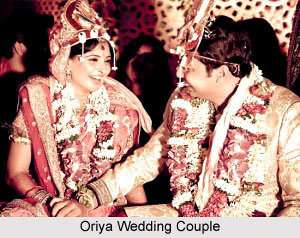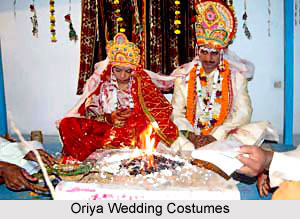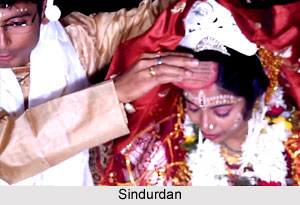 Oriya marriage is one of the integral parts of the Oriya culture originating in the state of Orissa. The wedding ceremony and rituals are very similar to those of the Hindu marriage ceremony but are definitely different in many aspects. There are subtle differences in the rites for different castes. Oriya people are not very extravagant and extrovert. They believe in simplicity and modesty. Their culture of simple living is very much reflected in their marriage rituals. However, the interesting fact about an Oriya wedding remains in the fact that the mother of the groom does not take part in the ceremony. The Oriya Brahmins have their weddings only in the daytime, preferably mornings, while the non-Brahmin weddings are in the evening or night.
Oriya marriage is one of the integral parts of the Oriya culture originating in the state of Orissa. The wedding ceremony and rituals are very similar to those of the Hindu marriage ceremony but are definitely different in many aspects. There are subtle differences in the rites for different castes. Oriya people are not very extravagant and extrovert. They believe in simplicity and modesty. Their culture of simple living is very much reflected in their marriage rituals. However, the interesting fact about an Oriya wedding remains in the fact that the mother of the groom does not take part in the ceremony. The Oriya Brahmins have their weddings only in the daytime, preferably mornings, while the non-Brahmin weddings are in the evening or night.
Costumes of the Oriya Couple - The Oriya bride is known to wear saree or lately lahengas and the groom wears dhoti and Punjabi, or sometimes drapes a white silk cloth around known as the "jor". In the reception, the groom wears formal attire, which may either be traditional or western.
Bridal attire - The bride in Orissa wears a sari or a lehenga in traditional rich colors like red, orange or magenta. She is adorned with fine gold jewelry. The bride`s mother, female relatives and her friends decorate the bride amid much jollity and pleasure. During a wedding the Oriya people give great significance to matters related to the wedding clothing.
There are a variety of dresses and costumes, which are worn by the Oriya bride and groom on special events like a wedding. The sari is one garment, which is worn by the women in all over India in wedding. The Oriya wedding sarees are simply mind-boggling. Different kinds of materials are used to manufacture some of the most beautiful looking saris. The wedding sarees are usually made of silk, cotton, chiffon and so on. These sarees are quite easily available in the leading garment stores, which are found in the country of India. The color of the saree should be decided on the basis of the bride`s complexion.

Groom`s Attire - The men in India also attach great importance to their wedding attire and the dhoti is one of the major clothing items, which they prefer for such events. The dhoti is one of the most elegant wedding clothing, which the men in India wear on special occasions, which includes a wedding.
It is worn, or rather draped around, the waist in a particular pattern. The dhotis are worn during weddings only in some selected regions of the country and Orissa is one of them. In an Oriya wedding, the bridegroom adorns the dress of a dhoti with the punjabi to go with it. The Punjabi is a richly decorated garment available in various colors. The wedding dress of dhoti and punjabi can be bought from the garment stores. One could also get it custom made in order to get the perfect fit. The men often wear a elegant looking Punjabi, white or cream colored dhoti and one scarf kind of "uttariya". While the wedding rituals are on, the grooms wear the "jor", which is a white colored silk cloth draped around the bare body of the grooms and signifies purification.
The Oriya wedding Rituals - A remarkable feature of the Oriya marriage is that the groom`s mother is not allowed to participate in the wedding ceremony. The Oriya wedding is one of the most simplified yet elegant ceremonies. Once the marriage alliance is fixed, the ceremony starts up with Nirbandh, a function very similar to an engagement. The fathers of the bride and groom make a promise to get their children wed to each other.
Pre-Wedding Rituals
Jayee Anukolo Ceremony: Jayee Anukolo ceremony marks the initiation of marriage rituals. This is followed by the distribution of invitation cards. The first card is sent to the family divinity. The second invitation goes to the bride and groom`s maternal uncle. Jayee Anukolo is the first ritual to be held. Invitation cards are distributed among friends and relatives and the first card is placed before Lord Jagannath. The second card is sent to the maternal uncles of the bride and the groom. Nirbandh is a function known as the engagement ceremony. The fathers of the bride and the groom take an oath to wed their children to each other.

Mangan Tradition in Oriya Wedding: In the Mangan tradition, people bless the bride and then apply turmeric paste on her body. This is followed by the bride`s ceremonial bath.
Jairagodo Anukolo - It is a ceremony, which marks the stoking of the fire. The bride is blessed with the smooth turmeric and bathed in the traditional ritual `Mangano`. A paste made from turmeric and sandal. Then this paste is applied to the body of the bride.
Diya Mangula Puja: Diya Mangula puja is conducted at the Devi`s temple. The female barber offers the bride`s bangles, toe ring, sindoor and sari to the Goddess. During the Diya Mangala Puja prayers are offered to the deity of a temple. The bridal saree, toe rings and sindoor are offered before the Lord by the barber and the blessings of the Gods invoked for a long and happy married life.
Barajatri & Baadua Pani Gadhua Custom: The groom along with his marriage procession arrives at the wedding venue with pomp and gaiety. This is known as Barajatri. Borojatri or Baraat is the ceremonial procession when the groom and his family members and friends arrive at the wedding mandap amid great pomp and magnificence. Upon arrival of the baraat the groom is greeted with aarti or tilak of which rice is an essential component. The bride is decorated with fine traditional jewelry. Oriya brides are seen generally dressed in red, orange or pink outfits for the wedding.
In the Baadua Pani Gadhua custom, the girl`s side informs the bride that the baraat has come. Thereafter, arrangements are made for her holy bath. The bride is informed of the groom`s arrival and then she takes another ceremonial bath called Baadua Pani Gadhua.
Wedding Day Ceremonies
A number of rituals lace the wedding day whilst making it a day far apart from the other three sixty-four days.
Kanyadaan: The wedding ritual begins with the Kanyadan ceremony held at the venue specially constructed for the wedding. This structure is decorated with lots of flowers and leaves. This is the traditional ritual of handing over the daughter to the groom. The customary fire is lit and the priests chant the mantras. Seven heaps of rice grain symbolizing the seven hills and the saptakulaparwata are worshipped during the saptapadi rite. The couple takes seven rounds around the fire symbolizing the sacred fire as the witness for the marriage. In this custom, the bride`s father gives his dear daughter`s hand to the groom with the promise that he will take care of her.
Haatha Ghanti Custom: In the Haatha Ghanti custom, the bride and groom take seven rounds around the holy fire, to the chant of mantras and shlokas. There is the ritual of Haatho Ghanthi. `Laja` which known as a puffed rice, a symbol of prosperity is offered to the fire. Brides in Orissa are considered as an avatar of Goddess Laxmi bringing abundance of wealth to the new home. Rice is tossed onto the path of the new wed, the new bride tilts a vessel of rice with her feet to spill the grains the threshold of her new home.
The bride`s brother stands behind the couple while the couple faces each other. The bride placed her hands on the grooms and her brother puts the puffed rice into them. Together they offer this Laja as `ahuti` or sacrifice to the God of fire amidst the chanting of mantras.
Post Wedding Rituals
Post wedding rituals further add zing to the wedding ceremony.
Grihapravesh Tradition: Laajo Hom is the conclusion of the wedding. The bridal couple arrives at the new home where the groom`s family gives her a warm ceremonial welcome called Grihapravesh. The bride, along with her husband, leaves for her new home, where the groom`s family gives them a warm welcome. This is known as Grihapravesh.
Astha Mangala Custom: On the eighth day after marriage, the newly weds visit the bride`s home, where yummy mouthwatering food is served. This is known as Astha Mangala custom. The bride and the groom are invited to the bride`s house on the eighth day after the wedding known as Astha Mangala. Delectable food is prepared and served for the newly married couple.
The girl receives sarees and jewellery from the groom. The blowing of the conch along with the sound of Hul-huli makes the atmosphere festive. Hul Huli is a sound made by placing the tongue on the roof of the mouth.
More on Marriage System in Indian States
More on Indian Wedding Accessories
More on Indian Religious Weddings
More on Types of Marriages
See also
 Oriya marriage is one of the integral parts of the Oriya culture originating in the state of Orissa. The wedding ceremony and rituals are very similar to those of the Hindu marriage ceremony but are definitely different in many aspects. There are subtle differences in the rites for different castes. Oriya people are not very extravagant and extrovert. They believe in simplicity and modesty. Their culture of simple living is very much reflected in their marriage rituals. However, the interesting fact about an Oriya wedding remains in the fact that the mother of the groom does not take part in the ceremony. The Oriya Brahmins have their weddings only in the daytime, preferably mornings, while the non-Brahmin weddings are in the evening or night.
Oriya marriage is one of the integral parts of the Oriya culture originating in the state of Orissa. The wedding ceremony and rituals are very similar to those of the Hindu marriage ceremony but are definitely different in many aspects. There are subtle differences in the rites for different castes. Oriya people are not very extravagant and extrovert. They believe in simplicity and modesty. Their culture of simple living is very much reflected in their marriage rituals. However, the interesting fact about an Oriya wedding remains in the fact that the mother of the groom does not take part in the ceremony. The Oriya Brahmins have their weddings only in the daytime, preferably mornings, while the non-Brahmin weddings are in the evening or night.



















